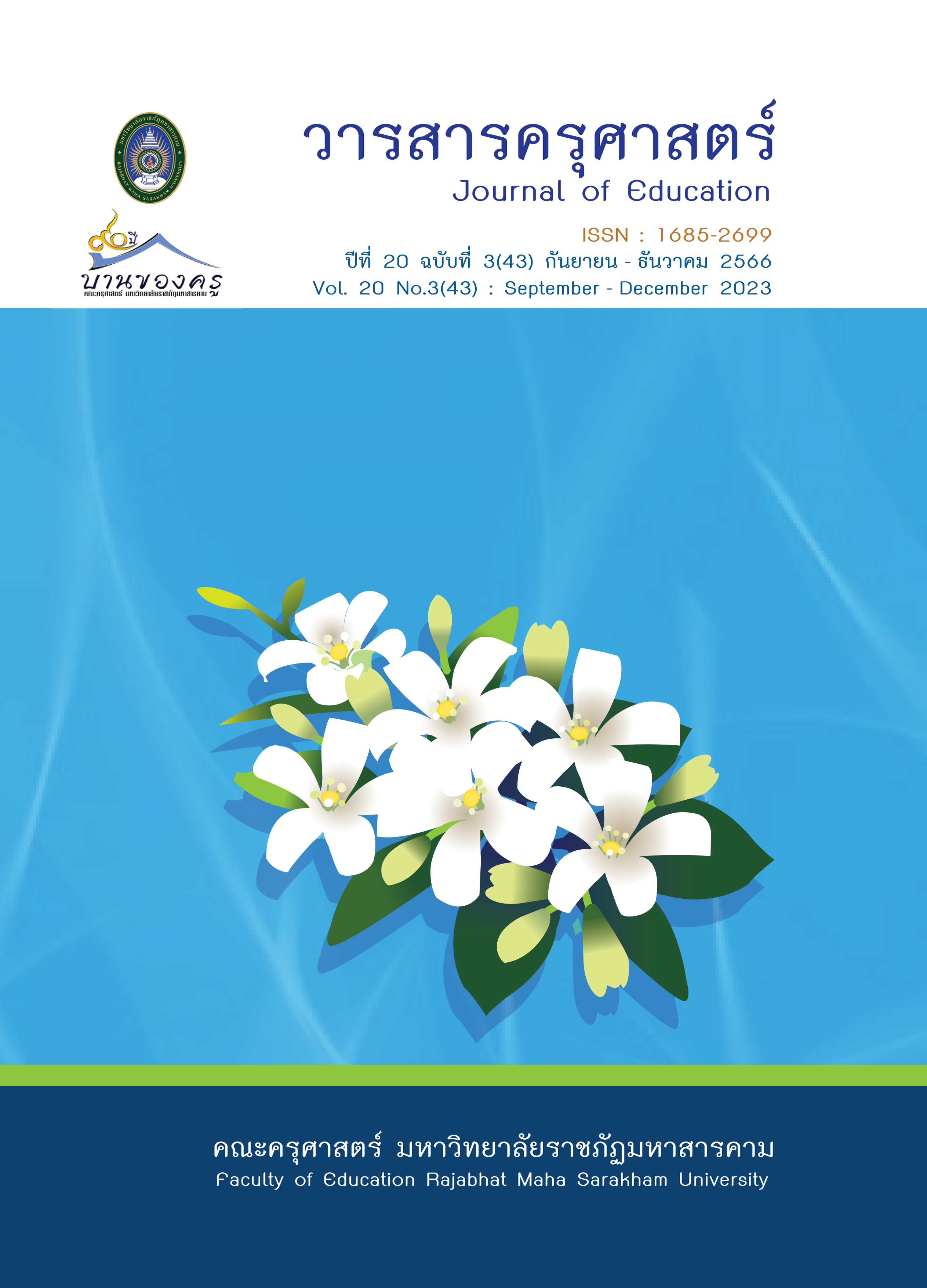Results of Challenge-Based Learning Activity in Innovation and Information Technology for Educational Communication and Learning for B.Ed.Students
Main Article Content
Abstract
The objectives of this research include to 1) develop the subject’s learning plans based on Challenge-based learning activity in Innovation and Information Technology for Educational Communication and Learning course. 2) compare the students’ achievement before and after learning with thee model. The samples consisted of 24 B.Ed.Students, Faculty of Education, Rajabhat Maha sarakham University. The research tools were 1) 4 learning management plans (4 hours each / 16 hours) with the consistency at the most appropriate level. 2) The quality assessment of learning management plans was proved by the experts. 3) an achievement test (50 multiple-choices test) with 0.73 of the reliability values. Mean and Standard Deviation (S.D.) were used for data analysis. Besides, Paired Samples t-test was employed for the hypothesis test.
The findings were as follows: 1) The result of the quality assessment of challenge-based learning management was at the best level. 2) The comparison achievement results found that after learning with the model the sample’ achievement scores were statistical significant at .05.
Article Details

This work is licensed under a Creative Commons Attribution-NonCommercial-NoDerivatives 4.0 International License.
ข้อกำหนดเบื้องต้นที่ผู้นิพนธ์(ผู้ส่งบทความ) ควรทราบ
1. ผู้นิพนธ์ที่ประสงค์จะลงตีพิมพ์บทความกับวารสาร ตั้งแต่เดือนมกราคม 2563 เป็นต้นไป ให้ใช้รูปแบบใหม่ (Template 2563) โดยสามารถดูตัวอย่างได้ที่เมนู GUIDELINES
2. จะตีพิมพ์และเผยแพร่ได้ ต้องผ่านการประเมินจากผู้ทรงคุณวุฒิ (Peer Review)
3. การประเมินบทความโดยผู้ทรงคุณวุฒิ (Peer Review) เป็นแบบ Double Blind
4. การอ้างอิงบทความใช้หลักเกณฑ์ APA (American Psychological Association) คลิก
5. บทความถูกปฏิเสธการตีพิมพ์ ไม่ผ่านการประเมิน ผู้นิพนธ์ขอยกเลิกเองหรือชำระเงินก่อนได้รับการอนุมัติ ทางวารสารไม่มีนโยบายการคืนเงิน
References
กองทุนพัฒนานวัตกรรม. (2545). เพาะปลูกความคิด ให้ดอกผลทางเศรษฐกิจ. วารสาร MBA, 4(38), 79.
กระทรวงศึกษาธิการ. (2560). ตัวชี้วัดและสาระการเรียนรู้แกนกลางกลุ่มสาระการเรียนรู้วิทยาศาสตร์ (ฉบับปรับปรุง พ.ศ. 2560). โรงพิมพ์ชุมนุมสหกรณ์การเกษตรแห่งประเทศไทย.
กาญจนา บุญภักดิ์. (2563). การเรียนรู้ ยุค New Normal. วารสารครุศาสตร์อุตสาหกรรม สถาบันเทคโนโลยีพระจอมเกล้าเจ้าคุณทหารลาดกระบัง. 19(2), 5.
ชัยวัฒน์ สุทธิรัตน์.(2564). การจัดการเรียนรู้เพื่อเปลี่ยนแปลง. เอ็ม ดี แอล กราฟิก.
พิชา ประจุศิลป์, กอบกุล สรรพกิจจำนง และณรง สมพงษ์ (2560). การเปรียบเทียบผลสัมฤทธิ์ทางการเรียนจากการเรียนรู้บนความท้าทายของนักเรียนชั้นมัธยมศึกษาปีที่ 3 ที่มีความพร้อมในการเรียนรู้โดยชี้นำตนเองแตกต่างกัน. วารสารสุโขทัยธรรมมาธิราช, 30(2), 114.
วิญญ์ทัญญู บุญทัน และคณะ. (2563). ผลการใช้รูปแบบการเสริมพฤฒพลังของผู้สูงอายุในชุมชน ตามแนวคิดการเรียนรู้โดยใช้สมองเป็นฐานและการเรียนรู้แบบท้าทาย. วารสารมฉกวิชาการ มหาวิทยาลัยหัวเฉียวเฉลิมพระเกียรติ, 24(2), 232.
เสกสรร สุขเสนา และวสวัตติ์ วงศ์พันธุเศรษฐ์. (2564). การเรียนรู้โดยใช้ความท้าทายเป็นฐานเพื่อส่งเสริมการแก้ปัญหาที่ถูกท้าทายในปัจจุบันของผู้เรียน. วารสารศึกษาศาสตร์ มหาวิทยาลัยศิลปากร, 18(1),112.
Apple Inc. (2008). Challenge Based Learning Take action and make a difference. Accessed July 15. Available, https://www.apple.com/ca/education/docs/Apple-ChallengedBasedLearning.pdf.
Apple Inc. (2011). Challenge Based Learning A Classroom Guide. July 15. Available, https://www.apple.com/br/education/docs/CBL_Classroom_Guide_Jan_2011.pdf.
Johan Malmqvist. (2018). From problem-based to challenge-based learning. Proceedings of the 11th International CDIO Conference, Chengdu University of Information Technology, Chengdu, Sichuan, P.R China, June 8-11.
Siemens. Georges. (2004). Connectivism A Learning Theory for the Digital Age. Retrieved April 21, http://www.elearnspace.org/Articles/connectivism.htm.


